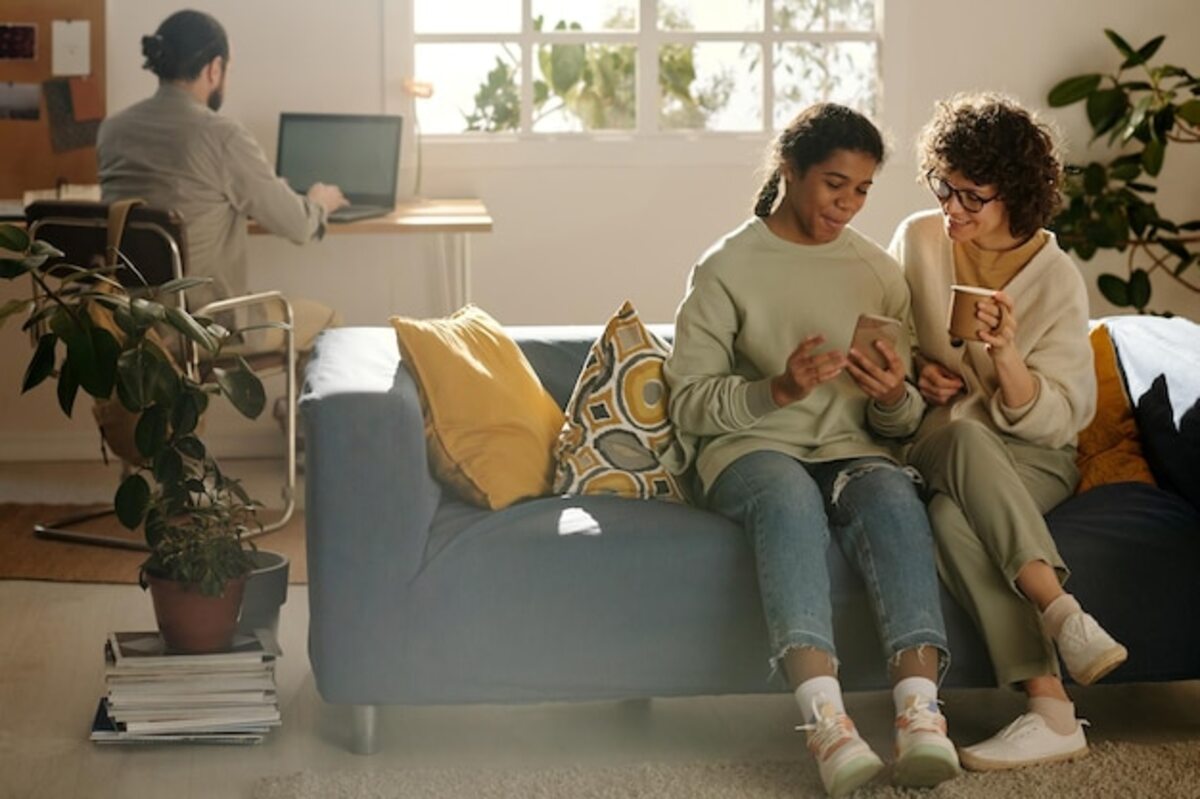Strengthen family communication with a cozy home.

Strengthen family communication with a cozy home. In daily life, the environment we create at home plays a fundamental role in family dynamics. A cozy home not only provides comfort but also encourages spaces for connection and dialogue. Discover how small changes in your home can transform communication among family members, creating an atmosphere where everyone feels valued and heard.
The importance of space: how design influences family communication
The arrangement and design of spaces in the home have a significant impact on family communication. A well-planned environment can facilitate smoother interactions, while a disorganized or unwelcoming space can hinder them. For example, having spacious and comfortable common areas, such as a living room where everyone can gather, encourages spontaneous dialogue and togetherness. By creating specific zones for family activities, such as a large dining table for dinners or a cozy reading nook, closeness and emotional connection among household members are promoted.
It is also essential to consider lighting and colors in home design. Warm tones and soft lighting can make spaces feel more inviting and relaxing, encouraging the family to spend time together. On the other hand, a cold or monotonous environment can create distance. Incorporating decorative elements that reflect shared personalities and memories also helps strengthen those bonds; seeing family photos or souvenirs from trips together evokes nostalgia and generates conversation topics that enrich daily interactions. Ultimately, a design aimed at family communication not only improves coexistence but also creates an emotional refuge where each member feels valued.
2. Colors that connect: the emotional impact of your home's palette
The colors we choose for our home have a deep emotional impact on how we feel and relate to others. Each shade evokes a psychological response that can influence our family interactions. For example, warm tones like yellow or orange are known to foster joy and energy, while blues and greens tend to convey calmness and tranquility. By carefully selecting a color palette for the different rooms, we are not only decorating our spaces but also creating an environment conducive to open and honest conversations among family members.
Additionally, it is important to consider how colors can help define different areas of the home according to their function. In a space intended for family leisure, such as a living room, you can choose vibrant colors that invite sharing fun and creative moments. On the other hand, in more intimate areas like bedrooms or studies, soft tones can promote reflection and rest. By implementing a conscious color strategy, we transform our home into an emotional refuge where each member feels motivated to communicate openly, thus strengthening family bonds in a welcoming and harmonious environment.
3. Furniture that invites dialogue: choosing functional and cozy pieces
To foster family communication, it is essential to select furniture that is not only functional but also invites dialogue and interaction. Pieces such as spacious and comfortable sofas, cozy chairs, and generous dining tables are ideal for creating an environment conducive to sharing moments together. By choosing furniture with an open and friendly design, closeness among family members is encouraged, facilitating conversations about daily life or simply enjoying quality time together. The arrangement of the furniture also plays a crucial role; placing seats in a circle or in positions that promote eye contact can work wonders for improving communication.
Additionally, opting for warm materials and soft textures helps create a cozy atmosphere that invites relaxation and openness. Furniture should not only be aesthetically pleasing; it should be pieces that tell shared stories and family memories. For example, a table where board games or craft activities take place can become the focal point during family gatherings. By integrating these elements into your home, you are not only creating spaces to sit and rest but also areas where dialogue flows naturally, thus reinforcing family bonds and promoting more effective communication.
4. Common areas: creating spaces for coexistence and discussion
Common areas in the home are essential for fostering coexistence and dialogue among family members. Spaces like the living room, kitchen, or dining area not only serve as places to gather but also act as catalysts for meaningful interactions. By designing these zones with a welcoming approach, using comfortable furniture, warm lighting, and decorative elements that reflect the family's personality, an environment conducive to conversation is created. A spacious sofa can invite sharing stories of the day, while a well-arranged table can facilitate moments of discussion and reflection on important topics.
It is also vital to consider how these common spaces are distributed. Designing open areas where everyone can see and hear each other fosters smoother communication. Incorporating elements like board games or books in shared areas can encourage family members to spend time together and engage in activities that stimulate dialogue. Remember that every corner should be a reminder of unity; small details like family photos or shared memories can further enrich the atmosphere, making everyone feel like an integral part of the home and promoting an environment where every voice is valued and respected.
5. The magic of family traditions: integrating memories into your decor
The magic of family traditions can be a powerful tool for reinforcing communication and a sense of belonging at home. Integrating meaningful memories into your decor not only beautifies the space but also offers each family member the opportunity to share stories and experiences. Framed family photographs, inherited objects, or even artifacts that represent special moments can become focal points that invite conversation. Every time someone pauses to admire a memory, a door opens to deep dialogues that strengthen emotional bonds.
By incorporating decorative elements that reflect family traditions, you create an environment where everyone feels included and valued. For example, if there is a special recipe that has been passed down from generation to generation, why not showcase it as part of your kitchen decor? These kinds of details not only add character to the home but also serve as a constant reminder of the family legacy. Thus, every time a moment is shared around that recipe, the story is revived, and the sense of community within the home is nurtured. At the end of the day, a home filled with memories is a place where every conversation finds its echo in the warmth of shared affection.
6. Technology at home: balancing the digital with the personal
Technology has transformed our daily lives, and home is no exception. However, it is essential to find a balance between the digital and the personal to ensure that these tools, instead of isolating, strengthen family relationships. Incorporating smart devices like voice assistants or entertainment systems can facilitate communication, but it is also crucial to establish screen-free moments. By dedicating time to activities like board games or family dinners, a space is fostered where each member can express themselves freely, thereby reinforcing emotional bonds.
Creating a technological environment that prioritizes human connection involves designing specific areas where the family can interact without digital distractions. For example, a well-equipped living room with comfortable seating and warm lighting invites meaningful conversations. Additionally, setting limits on device usage during certain hours of the day allows everyone to feel present and valued in their family relationship. By balancing technology with authentic personal interactions, a welcoming home is achieved that not only respects modern innovations but also nurtures affection and closeness among its members.
7. Aromas and sounds: how they stimulate a conducive environment for communication
The aromas and sounds we choose for our home can have a significant impact on the family environment. Soft fragrances like lavender or eucalyptus can create a relaxing atmosphere, facilitating smoother and more open conversations among family members. By incorporating essential oil diffusers or scented candles in common areas, not only is the air quality improved, but a conducive space for sharing experiences and feelings is also established. The association of certain scents with pleasant moments can help everyone feel more comfortable and willing to communicate.
On the other hand, sounds also play a crucial role in creating a welcoming environment. Soft background music can lighten the atmosphere and make interactions more enjoyable, while the natural sound of water or even a crackling fireplace adds a sense of tranquility. These sound elements help to ease tensions and promote a space where each family member can express themselves without fear of judgment. Thus, by being intentional with the aromas and sounds that surround us, we can transform our home into a place where communication flows naturally and family relationships are strengthened.
8. Family activities: promoting interaction through play and art
Family interaction is essential for building strong and lasting relationships. One of the best ways to promote this connection is through play and art, activities that are not only fun but also encourage creativity and communication. By dedicating time to board games or collaborative art projects, family members can express themselves freely, share ideas, and foster an environment where every voice is heard. These shared moments help create meaningful memories and strengthen family ties by turning the home into a place where collaboration and fun are celebrated.
Incorporating spaces within the home designated for these activities can transform your environment into a creative refuge. Whether it's a table in the living room dedicated to crafts, a cozy corner for reading stories, or an outdoor area for playing, each of these elements invites interaction and dialogue. Family activities, whether simple or elaborate, allow everyone to participate actively and feel part of the process. In this sense, promoting play and art not only entertains; it also becomes a powerful tool for enhancing family communication and strengthening emotional bonds among its members.
9. Open windows to communication: the role of natural light
Natural light is an essential element in creating a cozy home and, therefore, in promoting effective communication among family members. Windows that allow sunlight to enter not only illuminate spaces but also bring warmth and vitality to every corner of the home. By opening the curtains and letting the light flood the rooms, a more relaxed and friendly atmosphere is created, conducive to meaningful conversations. Additionally, natural light can positively influence our mood, helping to reduce stress and encouraging more pleasant interactions.
Incorporating elements that maximize natural light input, such as mirrors or light colors on the walls, also helps make all family members feel more connected. A well-lit space invites sharing moments together; whether during a family meal or while sharing anecdotes at the end of the day. The strategic arrangement of furniture around sources of natural light can facilitate open dialogue. In this sense, beyond aesthetic design, it's about creating an environment where each member feels that their voice matters and where interactions flow easily thanks to the transformative power of natural light.
10. Outdoor spaces: fostering conversations under the Costa Rican sky
Outdoor spaces are an invaluable resource for fostering family communication, especially in a privileged country like Costa Rica, where the weather invites enjoyment of nature. Creating a cozy corner in the garden, on the terrace, or even on the balcony can be an excellent way to bring family members together and facilitate meaningful conversations. Imagine an area with comfortable seating, plants that provide freshness, and perhaps a small table to enjoy snacks or drinks. These environments invite relaxation and connection without the typical distractions of the indoors.
Additionally, the natural environment can inspire deeper and more sincere dialogues. Under the Costa Rican sky, families can share stories, experiences, and dreams in a setting that promotes tranquility and reflection. The sounds of nature, such as the singing of the birds or the gentle rustle of the wind among the trees, create an atmosphere conducive to emotional openness. By dedicating time to these outdoor interactions, not only is family communication strengthened, but unforgettable memories are also built that will be etched in the hearts of each family member.



